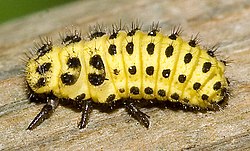Psyllobora vigintiduopunctata
| Psyllobora vigintiduopunctata | |
|---|---|

| |
| Scientific classification | |
| Domain: | Eukaryota |
| Kingdom: | Animalia |
| Phylum: | Arthropoda |
| Class: | Insecta |
| Order: | Coleoptera |
| Suborder: | Polyphaga |
| Infraorder: | Cucujiformia |
| Family: | Coccinellidae |
| Genus: | Psyllobora |
| Species: | P. vigintiduopunctata
|
| Binomial name | |
| Psyllobora vigintiduopunctata | |

Psyllobora vigintiduopunctata (often abbreviated to Psyllobora 22-punctata), the 22-spot ladybird, (earlier known as Thea vigintiduopunctata) is a common, 3–5 mm long ladybird native to Europe.[2] This species was originally discovered in Germany in 1874 on the leaves of Astragalus, consuming the hyphae of Erysiphe holosericea.[3] The elytra are yellow in colour with 22 black spots. The pronotum is yellow or white with 5 black spots.[4]
This is the only ladybird species in Britain and Ireland where the three life stages have very similar coloring and pattern; the pupa and larva look similar to the adult form, making them conspicuous and easier to identify.[5] Unlike most other ladybirds which feed on aphids, P. 22-punctata eats mildew — especially from umbellifers and low-growing shrubs .[6]
The 22-spot ladybird is best looked for amongst low vegetation.[7] It has occasionally been found in woodlands, on lower branches of young trees and in some coastal areas. [5] In a survey conducted between 1960 and 1965 by G.I. Savoiskaya in South-Eastern Kazakhstan, up to 500 individuals were found over-wintering together in the leaf litter at the bases of birches, hawthorns and wild apple trees. These instances were noted as being found between 1000 meters and 2000 meters above sea level. [8]
The Royal Botanic Gardens, Kew officially recorded their first 22-spot lady bird in 1969, publishing this finding along with many other additions to their wild flora and fauna records. [9]
The hemolymph of the 22-spot ladybird beetle contains a new dimeric alkaloid, psylloborine A, which has unique structural features, highlighting the species' complex chemical defenses and evolutionary adaptations. [10]
In Popular Culture
[edit]Philately
[edit]The 22-spot ladybird has been featured on multiple postage stamps around the world.
- 2008 - Jersey. Listed under it's former name of Thea vigintiduopunctata. Part of an illustrated six stamp "Insects" release. Designed by W. Oliver.[11]
- 2015 - Belarus. A set of four illustrated and embossed "Insects; Ladybirds" (also sometimes listed as "2015 Beetles") stamps issued. Designed by Marina Vitkovskaya and Alexander Mityanin. [12]
- 2017 - Slovenia. A set of three "Fauna; Ladybird" stamps issued. Designed by Robert Žvokelj. [13]
- 2017 - India. A set of four illustrated "Ladybird Beetles of India" stamps issued. Psyllobora vigintiduopunctata had a face value of 15 Indian rupee. [14]
- 2018 - Netherlands. Part of the "Experience Nature" series, featured in a ten stamp panel in the Insects and Spiders release. Designed by Frank Janse. [15]
- 2024 - Romania. A set of four ladybird photographic stamps issued. Psyllobora vigintiduopunctata had a face value of 5 Romanian Lei. Designed by George Ursachi.[16]
References
[edit]- ^ Linnaeus, C. 1758. Systema Naturae per regna tria naturæ, secundum classes, ordines, genera, species, cum characteribus, differentiis, synonymis, locis, Tomus I. Editio decima, reformata. Holmiæ: impensis direct. Laurentii Salvii. i–ii, 1–824 pp
- ^ G. Bradley (2006). "22-spot ladybird". UK Safari.
- ^ Karataraki, K.; Goumenaki, E.; Raftakis, E.; Goutos, D.; Kapetanakis, E. (2015-11-08). "First record of the mycophagous ladybird Psyllobora vigintiduopunctata on greenhouse cucumber plants in Crete (Greece)". Entomologia Hellenica. 24 (2): 37–41. doi:10.12681/eh.11544. ISSN 2459-3885.
- ^ Ansari Pour A, Shakarami J. Recognition of ladybird fauna (Col.: Coccinellidae) in the alfalfa fields of Khorramabad. The Journal of Animal & Plant Sciences. 2012; 22(4):939-943.
- ^ a b Roy, Helen; Brown, Peter (2018). Field Guide to the Ladybirds of Great Britain and Ireland. Bloomsbury Publishing. p. 78-79. ISBN 9781472935694.
- ^ Michael Chinery (1993). Collins Field Guide: Insects of Britain and Northern Europe. 3rd edition. HarperCollins. ISBN 0-00-219918-1.
- ^ Mathias, Dilllen (April 18, 2017). "Stronger diversity effects with increased environmental stress: A study of multitrophic interactions between oak, powdery mildew and ladybirds". PLOS ONE. 12 (4): e0176104. doi:10.1371/journal.pone.0176104. PMC 5395233. PMID 28419174.
- ^ Savoiskaya, G.I. (1966). "Hibernation and migration of Coccinellids in South-Eastern Kazakhstan". Ecology of Aphidophagus Insects. Symposium on the Ecology of Aphidophagus Insects. Liblice, Czech Republic: ACADEMIA, publishing house of the Czechoslovak Academy of Sciences, Prague.
- ^ Shaw, H. K. Airy (1973). "Additions to the Wild Fauna and Flora of the Royal Botanic Gardens, Kew". Kew Bulletin. 28 (3): 401. doi:10.2307/4108882. Retrieved 3 April 2025.
- ^ Schröder, Frank C.; Tolasch, Till (October 1998). "Psylloborine A, a new dimeric alkaloid from a ladybird beetle". Tetrahedron. 54 (40): 12243–12248. doi:10.1016/S0040-4020(98)00753-4.
- ^ "2008 Insects". www.stampworld.com. Stamp World. 2018. Retrieved 1 April 2025.
- ^ "Ladybugs". www.lastdodo.com. Netherlands: Last Dodo. 2023. Retrieved 29 March 2025.
- ^ "Ladybugs". www.lastdodo.com. Netherlands: Last Dodo. 2023. Retrieved 29 March 2025.
- ^ "Stamp: 22-spot Ladybird (Psyllobora vigintiduopunctata) (India 2017)". www.touchstamps.com. TouchStamps. 2017. Retrieved 25 March 2025.
- ^ "Insects and Spiders 2018". www.stampworld.com. Stamp World. 2018. Retrieved 1 April 2025.
- ^ "Romania Stamps, Ladybirds". www.wopa-plus.com. WOPA+ Stamps and Coins. 2024. Retrieved 25 March 2025.
 Media related to Psyllobora vigintiduopunctata at Wikimedia Commons
Media related to Psyllobora vigintiduopunctata at Wikimedia Commons Data related to Psyllobora vigintiduopunctata at Wikispecies
Data related to Psyllobora vigintiduopunctata at Wikispecies
Psylloborine A is distinguished from other alkaloids because of its two unbranched chains of 13 carbon units form two independent 2-methylazaphenalene systems.
